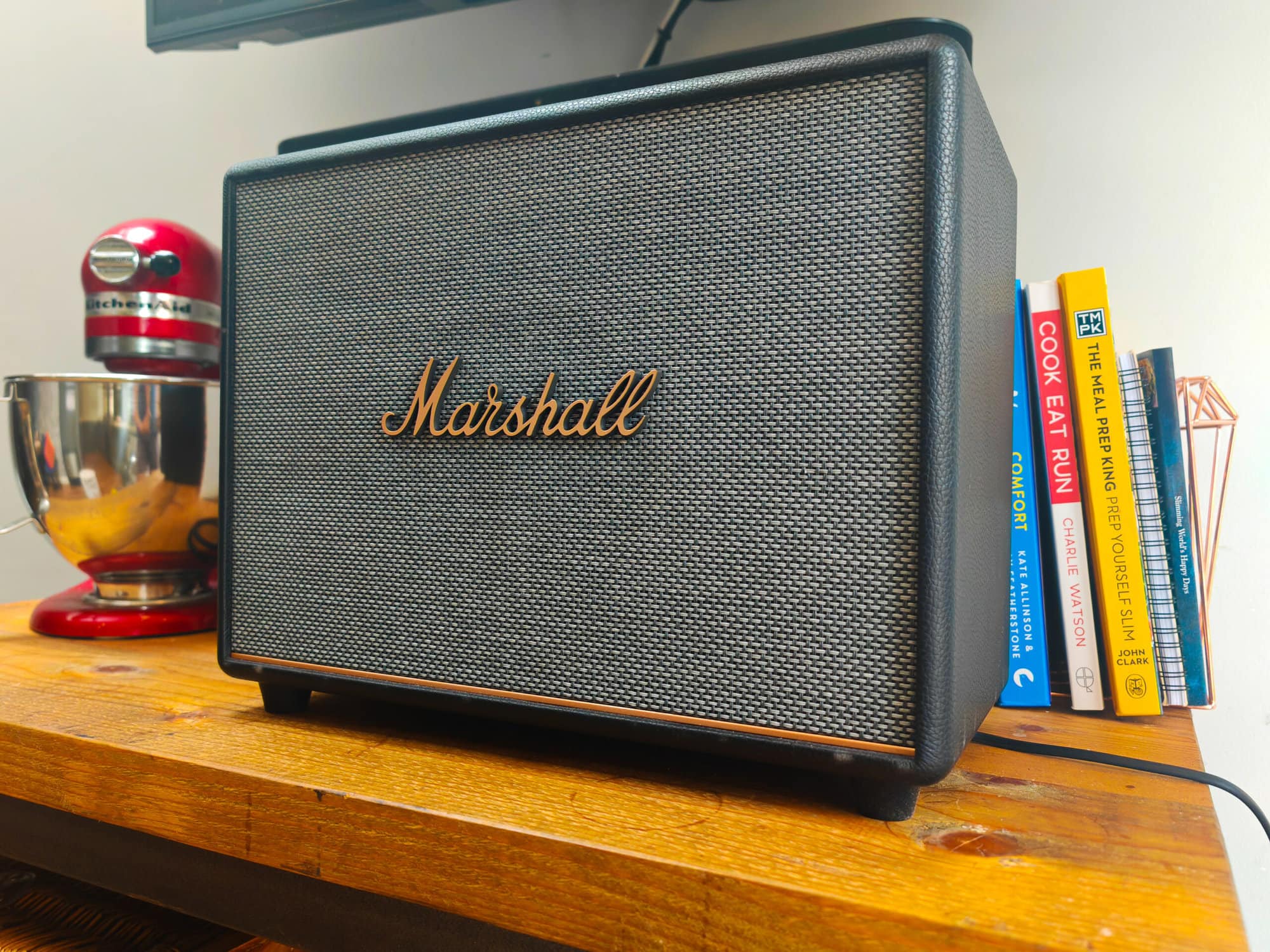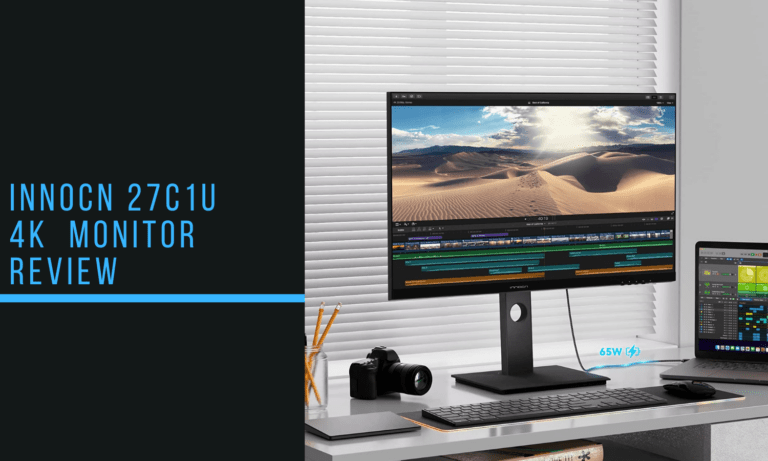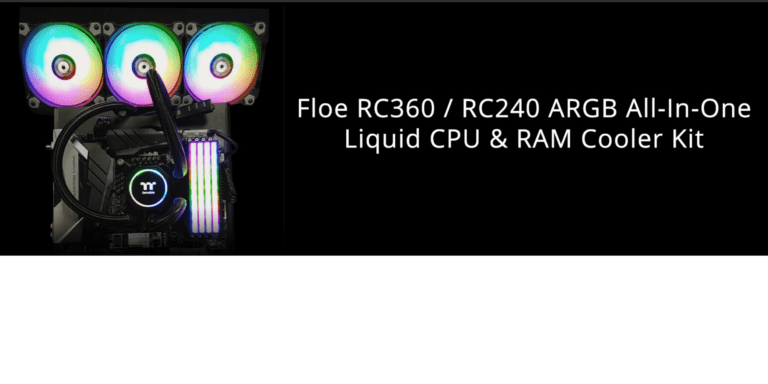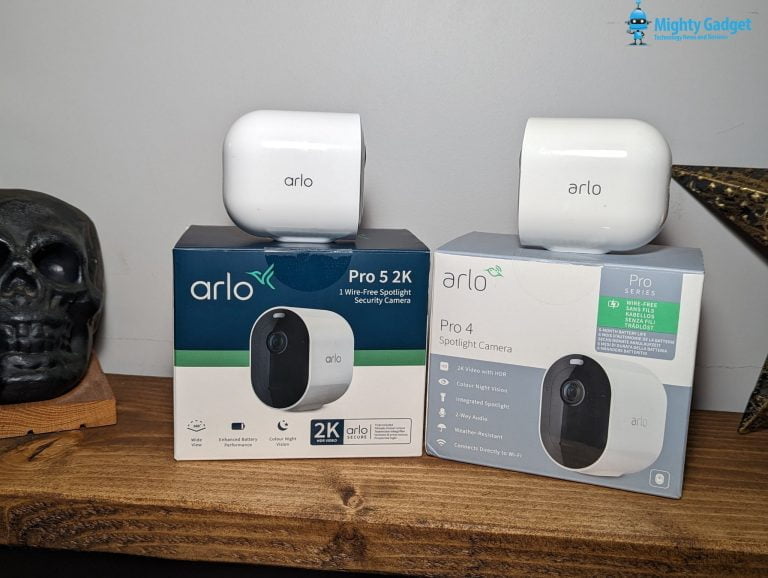Any links to online stores should be assumed to be affiliates. The company or PR agency provides all or most review samples. They have no control over my content, and I provide my honest opinion.
I have been working my way through reviewing the range of Marshall speakers and headphones. I have been impressed with everything from them so far. All the products have been priced at a premium, but you are paying for the name and the associated attractive signature design, build quality and the overall performance of the products.
I loved Marshal Middleton. It has been one of my favourite portable Bluetooth speakers. I have recently been reviewing the Marshall Woburn III, which I have been equally impressed with, and I am starting to think Marshell excel with its larger, more powerful speakers, where other brands often fall short.
| Preview | Product | Rating | Price | |
|---|---|---|---|---|

| Marshall Woburn III Bluetooth Speaker, Wireless - Black (UK) |
£518.98 | Buy on Amazon |
Specification
- Wireless stereo speaker
- Bass-reflex design
- Speakers:
- Tweeter x 2
- Midrange driver x 2
- Woofer x 1
- Power:
- One 90 Watt Class D amplifier for the woofer
- Two 15W Class D amplifiers for the mids
- Two 15 Watt Class D amplifiers for the tweeters
- 150W total power
- Frequency: 35 – 20,000 Hz
- 3-way driver system: lower, more controlled frequencies, clearer mids
- Dynamic Loudness function: Tonal balance adjustment to ensure brilliant sound at any volume
- Bluetooth 5.2 wireless connection
- Top panel controls: play/pause, volume, on/off, source, bass, treble
- Inputs: HDMI, 3.5 mm jack and RCA
- Mains powered
- Marshall mobile app:
- Pairing and onboarding
- Remote control
- Stack mode
- EQ
- Updates
- PVC-free design with 70% recycled plastic and 100% vegan materials
- Dimensions :400 x 317 x 203 mm (H x W x D)
- Weight: 7.45 kg
Design
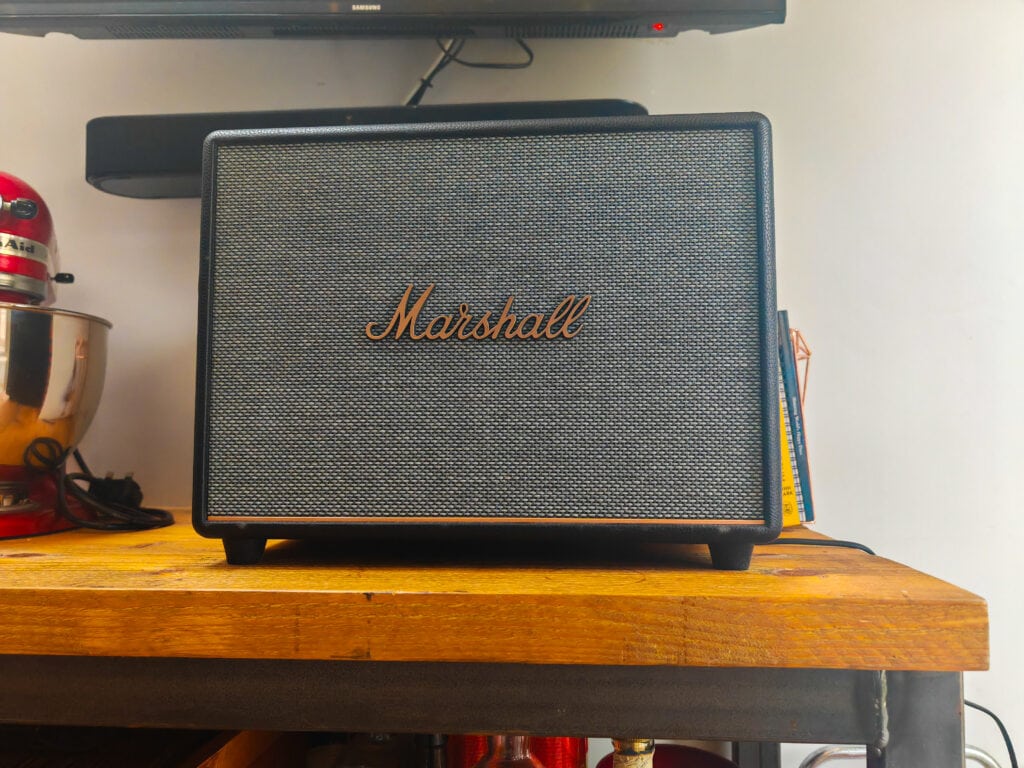

All the Marshall products have that signature retro-style Marshall look, and this is no different. If anything, it is even more Marshall than the other speakers I have reviewed due to its overall size and appearance of an amplifier.
It is an unashamedly large monolithic speaker that is not dissimilar to their famous guitar amplifiers.
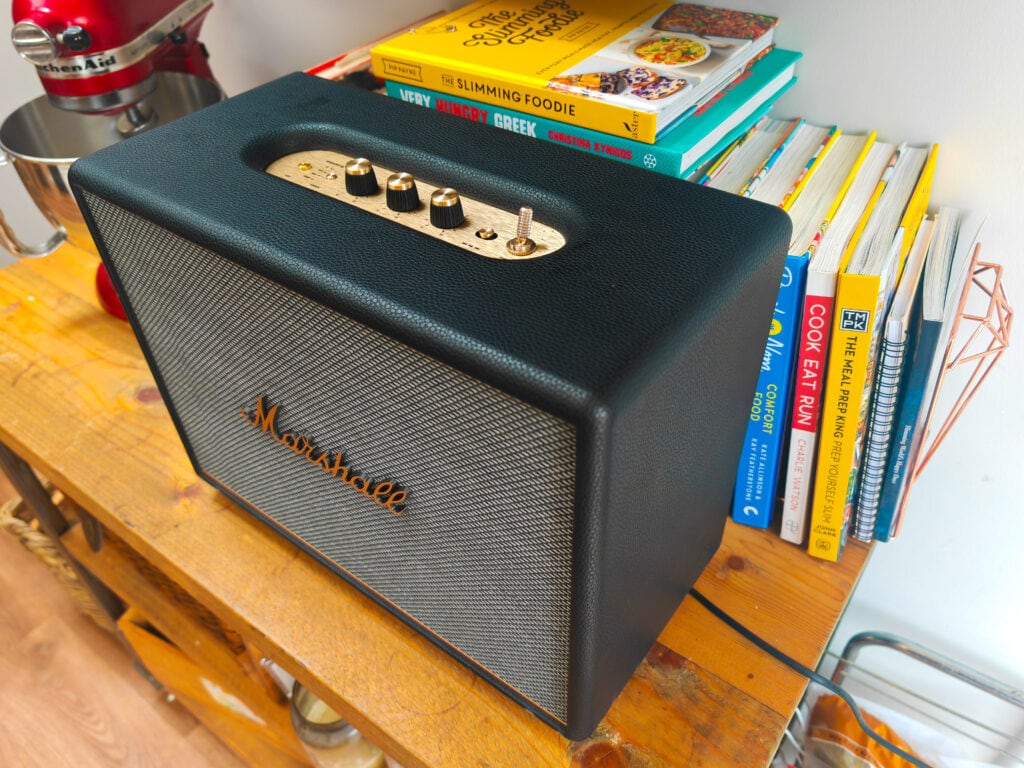

Marshall seems to have been reluctant to embrace modern connectivity and currently just has the Marshall Uxbridge that is capable of WiFi connectivity with voice control.
The inclusion of a HDMI input port is interesting. It is not the sort of speaker I’d normally associate with a TV, but there is no denying that this would be a big upgrade to the built-in audio of your TV. In my personal scenario, it would probably work out OK, as I have used this in the kitchen, and it just happens to be below the TV we have on the wall.


I love the dials and knobs for control. In particular, the power switch is pleasingly mechanical. The knobs let you adjust the volume, as well as the amount of bass and treble in the mix. You can also play and pause your audio using the button next to the power switch.
There are two colour options, cream and black, but the cream model is only available on the Marshal website.
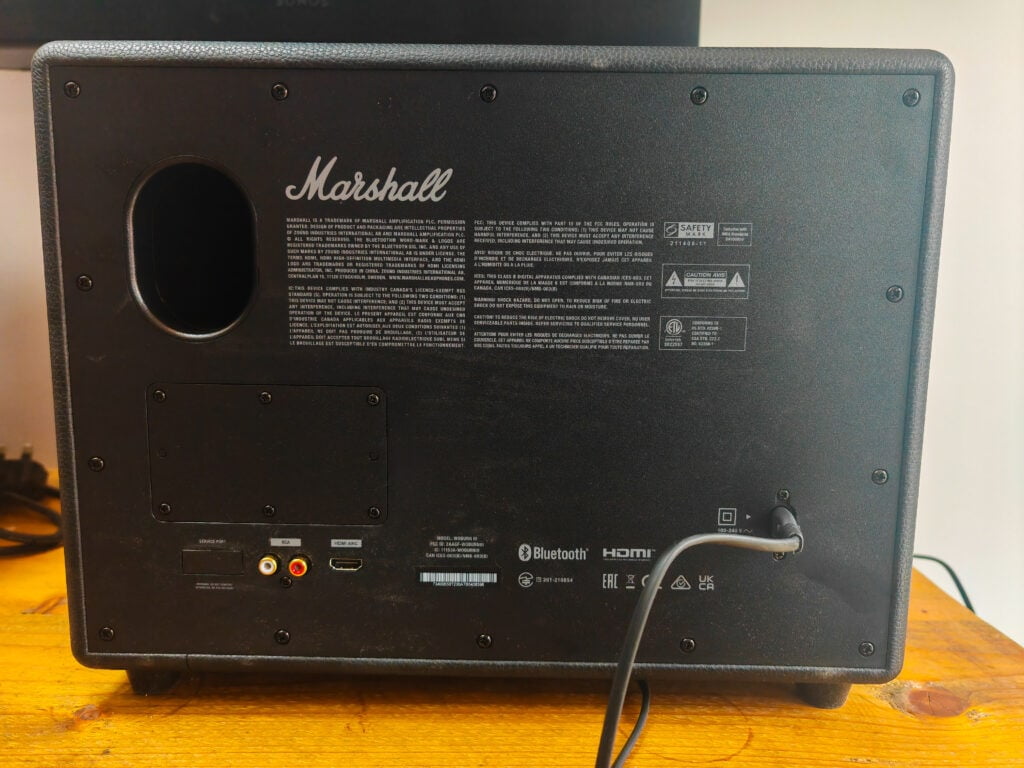

Marshal App




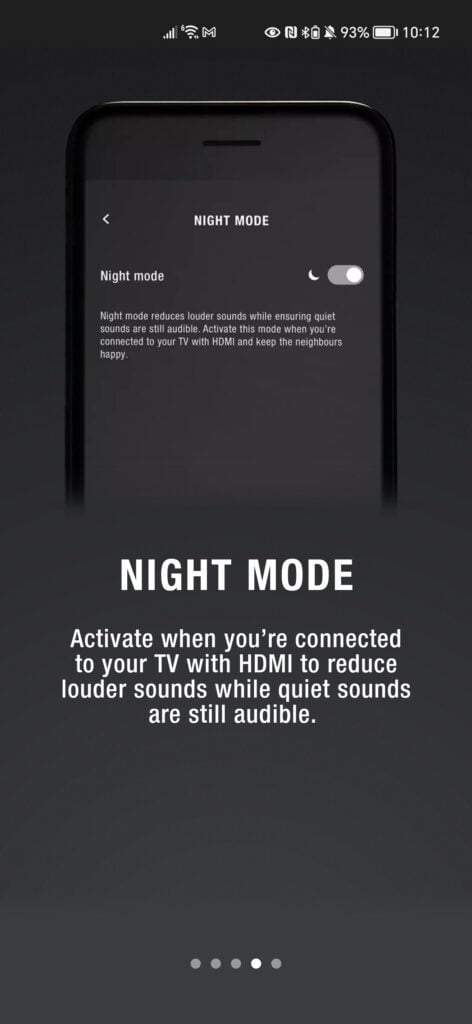

Like all the other Marshal products I have used, this has access to the Marshal app, which is attractively designed and comes with some useful features.
With this speaker, there is not a proper preset EQ like you have with the other Marshal products. This is due to the bass and treble dials being on the speaker itself.
The most useful feature of the app is the placement compensation feature which adjusts the sound based on your placement. It is like a simplistic version of the room calibration features you will find on AV receivers.
Sound Quality
I find it quite strange that the more affordable Woburn II Bluetooth has aptX, but this is limited to SBC, though you could bypass the limitations of SBC by streaming to something connected to the RCA input or HDMI.
At 150W of power is one of the most powerful speakers I have reviewed. It is even more powerful than my Edifier S3000 Pro, which I absolutely love and use in my office. It is only the £1200 Audio Pro A48 floor-standing speakers that I have reviewed, which are more powerful.
Obviously, power doesn’t necessarily mean these sound good, but you can be reassured that this speaker should be loud enough for most large rooms and demanding scenarios.
Thankfully, it is not just loud; it sounds great too. That 90W 6″ bass driver and additional rear port allow this speaker to provide exceptional low-end. You will likely want to tweak the bass dial to your liking, as much as I like room-thumping bass, it can be a little overpowering with some genres if you have it dialled up too high.
One thing I noticed, in my kitchen, on a wooden table, there was no unpleasant rattling from anything, nor could I hear any distortion at higher volumes.
With the bass and treble dialled in correctly, it manages to deliver deep lows without overwhelming the midrange, ensuring that bass-heavy tracks remain clear and without muddiness.
Vocals are front and centre, clear, and crisp. Whether you’re listening to the nuanced vocal renditions in soul tracks or crunching guitars in rock, the mid frequencies remain articulate and well-defined. This ensures a rich listening experience, with details shining through.
The high frequencies are bright enough to provide good detail without being piercing. Instruments like cymbals, high hats, and strings are rendered with clarity. Some might argue that there’s a slight roll-off at the very top, which keeps the sound from becoming overly sharp. This might be by design to ensure prolonged listening without fatigue.
Price and Alternative Options
| Preview | Product | Rating | Price | |
|---|---|---|---|---|
   | Marshall Woburn III Bluetooth Speaker, Wireless - Black (UK) |
£518.98 | Buy on Amazon |
The Marshall Woburn III has an RRP of £520 and can be found for around £500.
The older Woburn II is £470 and is less powerful with two 1″ tweeters and dual 5.25″ subwoofers are individually powered by class D amps for a total of 110 watts of power. It also lacks HDMI. Somehow, even though it is less powerful, it weighs a kilo more.
The Stanmore III is available for £350 and has one woofer and two tweeters with a power output of 80W.
The Bowers & Wilkins Zeppelin might be the best alternative option (I haven’t used it) which is about the same price. This also has five drivers and an impressive 240W output. It has superior aptX Adaptive codec support. It also has WiFi connectivity, Alexa and AirPlay 2, with high-resolution music streaming, but it lacks the HDMI port, so not much use if you want to use it with your TV. I prefer the look of the Marshall myself.
Overall
I love the Marshall Woburn III, and I would gladly sack off my Sonos Beam in favour of this for my kitchen speaker. I love how loud it is and its ability to produce room-filling bass without distorting.
Considering this is a £500 speaker, I would have liked WiFi connectivity giving me the opportunity to stream high-resolution music and avoid having to switch it on and connect my phone each time I want to use it. The 3.5mm/RCA inputs provide an alternative solution to this, an Echo Flex or Echo (4th generation) could easily add smart functionality.
Minor gripes aside, this is a superb speaker for anyone wanting something with serious power.
Marshall Woburn III Speaker Review
Summary
The Marshall Woburn III is a superb speaker for anyone wanting something with serious power.
Overall
90%-
Overall - 90%90%
Pros
- Incredibly powerful
- Outstanding bass
- Attractive retro design with nice tactile controls
- HDMI & RCA input
Cons
- No WiFi / Voice Control
I am James, a UK-based tech enthusiast and the Editor and Owner of Mighty Gadget, which I’ve proudly run since 2007. Passionate about all things technology, my expertise spans from computers and networking to mobile, wearables, and smart home devices.
As a fitness fanatic who loves running and cycling, I also have a keen interest in fitness-related technology, and I take every opportunity to cover this niche on my blog. My diverse interests allow me to bring a unique perspective to tech blogging, merging lifestyle, fitness, and the latest tech trends.
In my academic pursuits, I earned a BSc in Information Systems Design from UCLAN, before advancing my learning with a Master’s Degree in Computing. This advanced study also included Cisco CCNA accreditation, further demonstrating my commitment to understanding and staying ahead of the technology curve.
I’m proud to share that Vuelio has consistently ranked Mighty Gadget as one of the top technology blogs in the UK. With my dedication to technology and drive to share my insights, I aim to continue providing my readers with engaging and informative content.
Last update on 2024-04-27 / Affiliate links / Images from Amazon Product Advertising API

